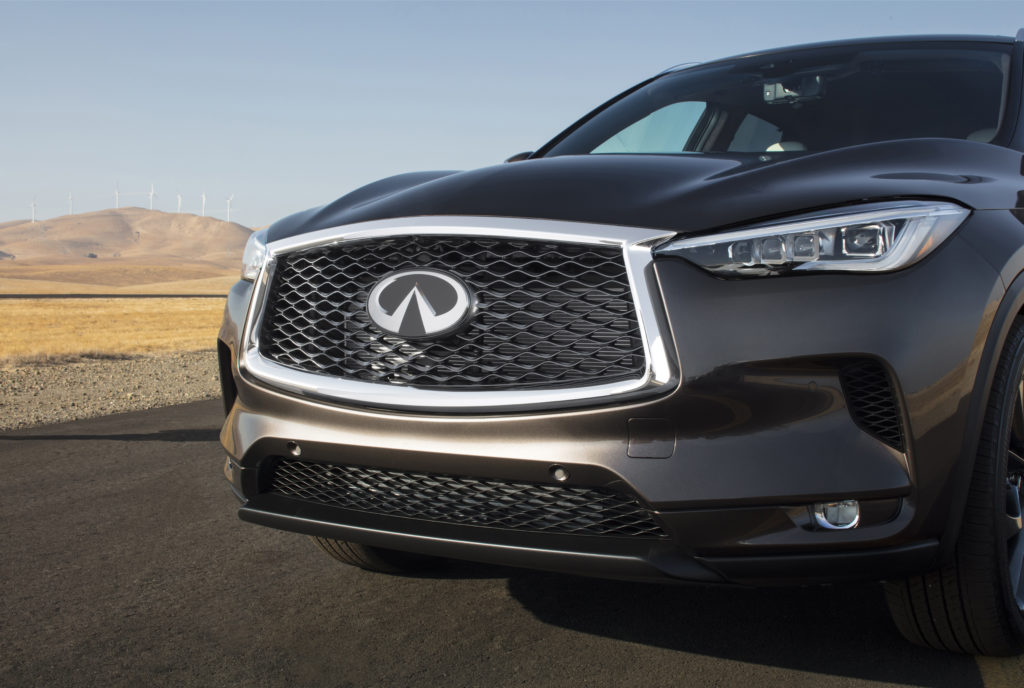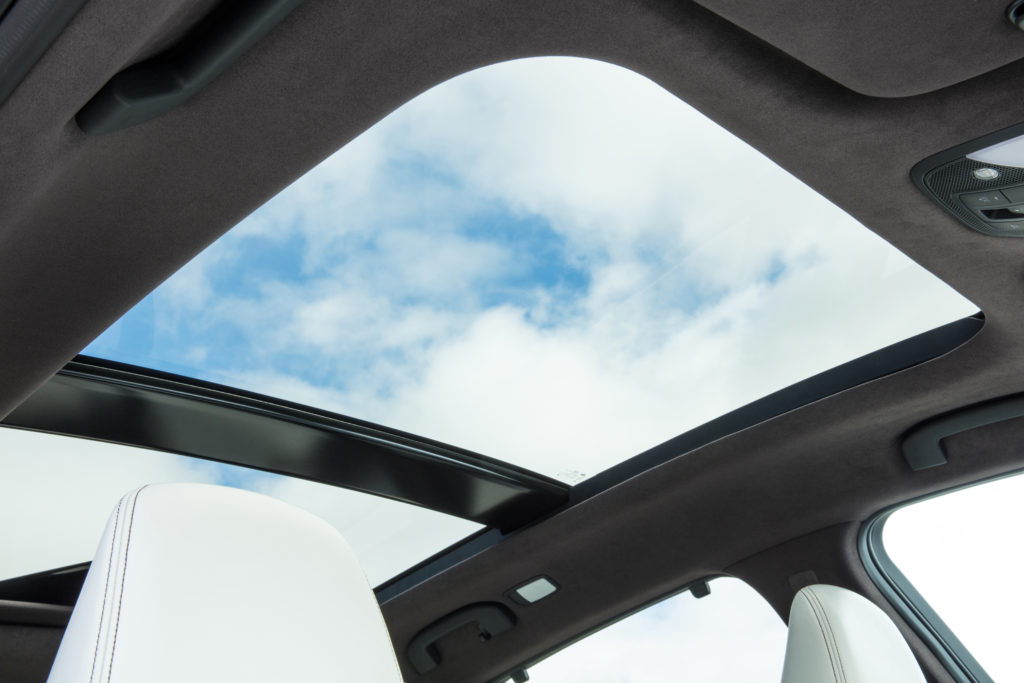
2019 Infiniti QX50 27% UHS steel; includes new high-formability 980 MPa
By onMarket Trends | Repair Operations | Technology
The next-generation 2019 Infiniti QX50 is now on sale, and buyers will be the first Nissan owners to receive the benefits of a new 980-megapascal “Super High Formability” ultra-high-strength steel.
Nissan on Monday called itself as the first OEM to use the metal, which the automaker created in partnership with Nippon Steel & Sumitomo Metal and first used on the QX50.
Nissan described the formability as “previously unachievable” in steel with that tensile strength.
“The high-tensile material can be molded into unprecedented shapes, saving weight and representing a torsional rigidity improvement of 23 percent over the current QX50,” Infiniti wrote in a November 2017 news release. “This rigidity allows the car to resist flex and vibrations, while reducing the noise transmitted to the cabin.”
QX50 collision repairers will certainly encounter the new 980 MPa steel, which appears to be an example of the “third-generation” strong and shapable steels coming to market.
“(T)he SHF 980 MPa steel is used around the crashable zones at the front and rear of the car, to better absorb energy in the event of a collision, as well as weight-bearing sections around the engine bay and other key structural parts of the car, such as the B-pillar,” Infiniti wrote.
Infiniti also used 1.2-gigapascal steel (1,200 MPa) in the passenger cage to protect occupants. On the whole, 27 percent of the vehicle’s parts weight comes from ultra-high-strength steels. (Nissan considers ultra-high-strength steel to start at 980 MPa, rather than the 780 MPa threshold some use.)
“High tensile steel is used throughout the rest of the bodyshell,” Infiniti wrote, and a look at the QX50’s OEM repair procedures indicates numerous components between 440-979 MPa classified as high-strength steel.
“In addition to reducing flex and body vibrations, the high rigidity body provides a stable base for the all-new QX50’s front and rear suspension systems, steering and brakes to perform optimally and provide the driver with greater control,” Infiniti wrote.
The extensive high- and ultra-high-strength steel shaves weight out of the vehicle. Though some variants of the 2019 QX50 weigh more than their 2017 predecessor, others are lighter — despite the newer vehicle being wider and taller. The 2019 QX50 also gets 6-7 mpg better gas mileage than its predecessor.
“The all-new QX50’s body-mass index (the bodyshell’s ratio of weight-to-size) is one of the best in the segment,” Infiniti wrote. “The body-in-white is large but lightweight, weighing just 923.7 lbs. A double-ring structure provides the bodyshell with a naturally strong frame, in particular reinforcing the rear of the car and the area around the tailgate, contributing to ideal rigidity.”
Repair restrictions
The high- and ultra-high-strength steel in the QX50 mean repairers will face restrictions on what they can do. Throw out your mild steel playbook and consult the OEM repair procedures.
For example, the ultra-high-strength steel parts are replace-only. As Infiniti writes in the 2019 QX50’s OEM repair procedures (which work best in Internet Explorer):
Ultra high strength steel (UHSS) means the steel from 980 MPa or higher.
Never cut and joint the panel, plate and reinforcement made of ultra high strength steel (UHSS).
If such part is damaged, replace the part.
Infiniti in its 2019 QX50 instructions also doesn’t recommend you heat 440-979 MPa reinforcements at all “since it may weaken the component.” (Heat is Kryptonite to higher-strength steels; it lowers the tensile strength.) However, if heating is unavoidable, the temperature can’t exceed 550 Celsius/1,022 Fahrenheit, according to Infiniti.
“When you heat the HSS or UHSS parts above 550°C (1,022°F), it must be replaced with new parts,” Infiniti wrote.
Infiniti also advises to use a saw instead of a torch to cut those steels “to avoid weakening surrounding areas due to heat.” Any torch cutting must have a margin of 50 mm at least.
It also warned that pulling high-strength steel parts can cause unexpected deformation because of the metal’s strength.
“In this case, increase the number of measuring points, and carefully pull the HSS panel,” the OEM wrote for the QX50.
Other features
Other severity- and complexity-increasing elements on the QX50 possibly of interest to collision repairers:
Vehicle exterior: The hood has a hinge system known as “Pop-Up 4 Link Hinge” created specifically for the QX50.
Infiniti boasted of its bodylines, which integrate the door handles and were created with the OEM’s “own deep-sculpting manufacturing methods.”
“The deep-stamping production methods behind the new QX50’s bodywork enable the creation of an integrated door design,” the OEM wrote. “This results in an almost-seamless connection between the door glass and metal.”
The hood, tailgate, A-pillar and a covered underbody boosted the vehicle’s drag coefficient by 6 percent, according to Infiniti.
The grille has “no gaps between the grille and the hood.” It also is higher but preserves the car’s ability to meet pedestrian crash test rules abroad.
Lights: LED headlights and taillights are standard, and the front ones might be difficult to copy by an aftermarket competitor.
“Advanced headlight technology lights up the road ahead, from every angle,” Infiniti wrote. “Light guide technology uses a series of reflective channels to disperse light from the LED accents, spreading light evenly.”
ADAS: The new ProPILOT Assist advanced driver assistance suite, which is split into two options packages, allows the 2019 QX50 to drive itself within a single highway lane.
“ProPILOT Assist takes over single-lane driving operation at the push of a button, without the driver’s input on acceleration, braking, or steering,” Infiniti wrote. “The driver can choose to let the car operate on their behalf in stop-start traffic.”
The QX50 also offers a variety of other ADAS features. Some of them appear to only be available on the top-of-the-line Essential trims, while others might be more prevalent.
“The technologies that make up the full suite of QX50’s ProPILOT Assist system include Direct Adaptive Steering and Intelligent Cruise Control,” Infiniti wrote. “These are supported by additional technologies, including: Distance Control Assist; Back-up Collision Intervention; Predictive Forward Collision Warning; Blind Spot Warning and Intervention; Lane Departure Warning and Prevention; and Forward Emergency Braking with pedestrian detection. Other notable safety features available to 2019 QX50 buyers include pre-crash seat belt technology, adaptive front lighting with high beam assist, a tire inflation indicator, and lighter steering for certain parking situations. …
“An Around View Monitor (AVM) offers a 360-degree overhead view of the space around the QX50, displayed on the center console screen, to aid parking in tight spaces. Moving Object Detection (MOD) works in tandem with AVM to alert the driver of people or objects that move into proximity of the vehicle. When in reverse, the system automatically applies the brakes if it senses the driver has not taken action. In addition to the birds-eye view, AVM also offers drivers a curb-level view, to reduce the risk of scratching the wheels or fenders on a high curb.”
Drive-by-wire: Drivers can obtain the fourth-generation version of Infiniti’s Direct Adaptive System — a steer-by-wire method which “eliminates the need for mechanically linked parts, instead employing digital components to improve steering feel and feedback.” This could affect collision repair procedures following a crash.
Run-flat tires: Run-flat tires on the SUV are an option, and would have to be replaced with other run-flats to meet pre-loss condition.
“The application of run-flats enables the fitment of low-profile tires around the 20-inch wheels, while special reinforced rubber sidewalls allow the tires to work with reduced air pressure for up to 93 miles,” Nissan wrote.
Cabin: The vehicle has the option of a heads-up display projected on the windshield.
An option provides gas sensors that “detect outside odors and will revert to recirculated air, a plasma cluster ionizer deodorizes the cabin, and charcoal or grape polyphenol filters are available to remove allergens and unpleasant odors.”
An optional panoramic moonroof “from the front row through to the cargo area” is available.
More information:
Infiniti, Nov. 28, 2017
“Nissan to use ultrastrong, high-formability steel in more new vehicles”
Nissan, June 18, 2018
Nissan collision repair procedures website (use Internet Explorer)
Infiniti collision repair procedures website (use Internet Explorer)
Images:
Nissan debuted a new 980 MPa “Super High Formability” steel on the 2019 Infiniti QX50 and ultimately built 27 percent of the SUV out of ultra-high-strength steel. (Provided by Infiniti)
Nissan on Monday announced it would seek to have 25 percent of its vehicle parts weight derived from ultra-high-strength steel components of at least 980 megapascals. The OEM noted it debuted a new 980 MPa high formability steel on the 2019 Infiniti QX50. (Provided by Nissan)
The next-generation 2019 Infiniti QX50 has an optional moonroof. (Provided by Infiniti)




